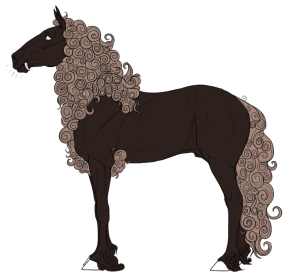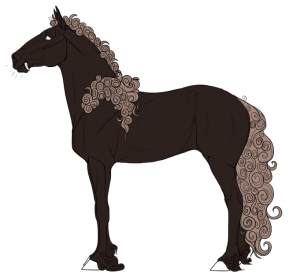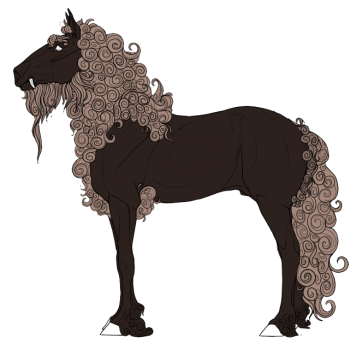
- Ballator Breed Information
- Ballator Lore
- Ballator Design Guide
Other Ballator Types
General Information
The Asiatic Ballator is thought to be one of the oldest Types of Ballator. It is not exactly known when these mysterious Ballators first made their appearance, or when they first came into contact with humans. Native to Asia, these Ballators are the size of a modern day medium-sized horse, with sturdy yet light build and many unique qualities that have ensured their popularity.
Physical Description & Sexual Dimorphism


Asiatic Ballators will almost always have antler-like horns, much like the drawings and depictions of Asian dragons. The hair of the Asiatic ballator is so densely curled that it appears much like that of a Foo Dog. The hair rarely has a straight strand; it is not flowing with a few curls. The Stallions of this type have full, lush manes that cover the entire neck and end at the shoulder mane, along with thick elbow manes. Mares, on the other hand, only have a common horse-like mane on their necks that is short and never grows longer than 6 inches and is always erect. Both sexes can have very thick, curly feathering on the feet.
Asiatics have a wide variety of possible extra manes, such as eyebrow tufts, extended hair on the back of the rump, and stallions can grow long, thick, extensive beards. Full back manes are also common.

While Asiatics can puff up manes like other types, due to the thick curliness of their hair, they cannot rattle the shoulder manes as other types do.
Unlike most other types, the Asiatic has an older, much more reclusive sub-type known as the Ancient Asiatic. These horses successfully evaded all contact with humans until very recently, and are characterized not only by strictly antler-like horns, but by the presence of unique, multi-toed feet. The hooves are cloven, with two sets of protruding ‘toes’ on the fetlocks, that can range in size from large to small. These hooves allow a high degree of sure-footedness on rocky slopes and rough terrain. If an Ancient is bred with a Modern Oriental, the foal can have cloven hooves and toes on all feet or just on two, or normal hooves. It also may have cloven hooves and no toes.
Asiatics’ adult horns and manes will be finished growing at 7 years of age, at which they are considered adults.
The height of an Asiatic is between 14 – 16 hh.

Behavior
Herd: Living in small herds of just a few Asiatics, these horses tend to remain in herds sectioned by Type; it is rare to see a Modern in an Ancient herd and vice versa. Very reclusive and sure-footed, an Oriental can inhabit anywhere from rocky cliffs to rolling fields, but they prefer a certain degree of privacy and will search out places to hide. Because of this, they have remained undiscovered for a very long time. Stallions may be loners, but mares tend to cluster together in pairs or small herds of 2-6 horses.
Feeding: Feeding mainly on a plant-based diet, Asiatics are fond of herbs and tender water plants. They will hunt if times call for it, but they use their canines mainly for the purpose of digging up roots.
Defense: Being a very wise and contemplative type, an Asiatic can evade danger before many other types have even noticed there was a present threat. However, if they are caught up in an inevitable fight, they will puff up their manes to appear larger. Because of the thick curliness of their hair, they cannot rattle the shoulder manes as other types do, but they can growl and bellow to warn a predator or threat to come no closer. They will not fight for long, merely attack with the hopes of a quick and easy escape.
Breeding: Secretive and illusive, Asiatic breedings have never been witnessed in the wild, which raises speculation that a pair will go off by themselves for a time to breed in secret away from a herd. They tend to be very caring mates, nursing young lovingly and taking utmost responsibility for their foals.
Special Information
Breeding an Asiatic with any other type will always result in a dead foal.
Asiatics are the only presenters of Fu and Bi-Color genes.
